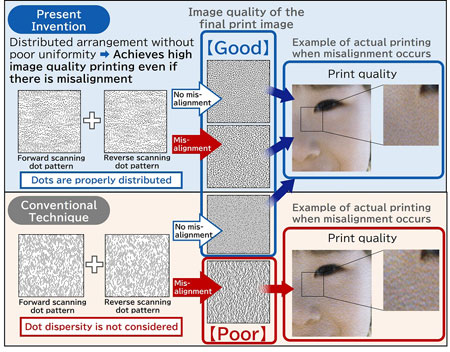Epson Awarded the Japanese Minister of Education, Culture, Sports, Science and Technology Prize at the National Commendation for Invention 2022
- Invention of method to reduce printing unevenness during bidirectional printing with inkjet printer -

Education, Culture, Sports, Science and Technology Prize
- TOKYO, Japan, May 31, 2022 -
Seiko Epson Corporation (TSE: 6724, "Epson") today announced that "The Invention of a Method to Reduce Printing Unevenness during Bidirectional Printing with Inkjet Printer (Japanese Patent No. 4635762)" has received the Japanese Minister of Education, Culture, Sports, Science and Technology Prize at the National Commendation for Invention 2022 (sponsored by the Japan Institute of Invention and Innovation). This is the second time Epson has won the award, having won it in 2006 for "The Invention of Pre-Charge Driven LCD Equipment (Japanese Patent No. 2669418)." It is also the second consecutive year Epson has won a prize at the National Commendation for Invention, having won the Prime Minister's Prize in 2021.
A ceremony will be held on June 30 at The Okura Tokyo, Minato Ward, Tokyo.
The National Commendation for Invention* is intended to encourage invention and contribute to the improvement of science and technology in Japan and the development of industry there by honoring those who have completed outstanding inventions or designs in Japan and those who have contributed to the implementation or promotion of inventions. The Ministry of Education, Culture, Sports, Science and Technology Minister's Prize ranks just after the Imperial Invention Prize and the Prime Minister's Prize in commendation category No. 1, which covers inventions showing outstanding technological inventiveness and significant embodiment effects.
The invention receiving a prize this year was praised as a technology that prevents image roughness during bidirectional printing. Inkjet printers print bidirectionally as the printhead is reciprocally scanned over the paper, ejecting ink during both forward and reverse scanning to form a dot pattern. In this invention, dots are distributed so that the optimal dot patterns can be achieved in both scanning directions.
The technology has helped to achieve inkjet printers of high speed and image quality for home, business, photography, and commercial and industrial use.
* The National Commendation for Invention started with the first Imperial Commendation for Invention in 1919, and is sponsored by Ministry of Education, Culture, Sports, Science and Technology, Ministry of Economy, Trade and Industry, Japan Patent Office, Japan Business Federation, Japan Chamber of Commerce and Industry, Japan Patent Attorneys Association, and the Asahi Shimbun Company.
Prizes and winners
Japanese Minister of Education, Culture, Sports, Science and Technology Prize
Toshiaki Kakutani (Inkjet-Solution Technology & Business Development Department, IJS Operations Division, Seiko Epson Corporation)
Invention Implementation Achievement Prize
Yasunori Ogawa (President and Representative Director, Chief Executive Officer)
Comments from winner Toshiaki Kakutani
"It is an honor to receive such a prestigious award. I've devoted all my efforts to improving the image quality of inkjet printers since I joined Epson. I am thrilled to be rewarded with this prize, as well as the Minister of Economy, Trade and Industry Prize that I received in 2003. I'm additionally happy to know that more people have become interested in the power of Epson's image processing technology.
The current prize recognizes the many years of hard work that Epson and so many of my colleagues have done with their attitude of never compromising on image quality. As the applications of inkjets expand, I will continue my efforts to develop means of printing with high speed and image quality for all sorts of fields."
Overview of present invention (Fig. 1)
The present invention relates to bidirectional printing by an inkjet printer in which a print head is reciprocally scanned over a paper surface to form dots.
Bidirectional printing is essential for high-speed printing, but significant image quality deterioration such as uneven printing occurs due to misalignment between dots formed during forward scanning and dots formed during reverse scanning of the printhead.
Misalignment occurs due to various factors, which makes it difficult to eliminate.
In the present invention, dots formed during forward scanning and dots formed during reverse scanning are distributed to avoid poor uniformity in distribution, that is, the dots are distributed with blue noise characteristics that humans cannot perceive.
As a result, it is possible to print with high speed and image quality because poor uniformity of dots is suppressed even if there is misalignment.
The present invention enables inkjet printers of high speed and image quality for home, business, photography, and commercial and industrial use, and through print digitalization greatly contributes to reducing the burden on the environment, improving productivity, and cultivating a culture of photography, fashion, art, and more.

with present invention and conventional technique

See the following websites for more details about the invention that was awarded the Japanese Minister of Education, Culture, Sports, Science and Technology Prize.
Halftoning
corporate.epson/en/technology/search-by-products/printer-inkjet/half-toning.html
Dot Control Technology
corporate.epson/en/technology/search-by-products/printer-inkjet/dot-controll-technology.html
About Epson
Epson is a global technology leader dedicated to co-creating sustainability and enriching communities by leveraging its efficient, compact, and precision technologies and digital technologies to connect people, things, and information. The company is focused on solving societal issues through innovations in home and office printing, commercial and industrial printing, manufacturing, visual and lifestyle. Epson will become carbon negative and eliminate use of exhaustible underground resources such as oil and metal by 2050.
Led by the Japan-based Seiko Epson Corporation, the worldwide Epson Group generates annual sales of more than JPY 1 trillion.
corporate.epson/en/


